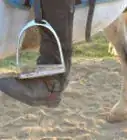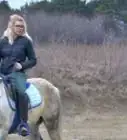This article was co-authored by Alana Silverman. Alana Silverman is a Certified EAGALA (Equine Assisted Growth and Learning Association) Equine Specialist and the Assistant Manager of Paddock Riding Club, a 200-horse premier equestrian facility based in Los Angeles, California. Alana has over 25 years of experience caring for and riding horses and specializes in English riding and riding instruction. She has a BA in Psychology from the University of Arizona.
There are 9 references cited in this article, which can be found at the bottom of the page.
wikiHow marks an article as reader-approved once it receives enough positive feedback. In this case, several readers have written to tell us that this article was helpful to them, earning it our reader-approved status.
This article has been viewed 192,851 times.
In general, there are two ways to ride a horse: English style and Western style. Western-style involves steering with your saddle position, hips, and light reining on a horse's neck (neck reining), whereas English style involves more close contact between the reins and a horse's mouth. Western-style riding involves a heavier saddle and requires just one hand on the reins while English style has a lighter saddle and uses both hands on the reins.[1] Western-style riding is useful because it can be more comfortable for a horse that has to work actively for long periods of time.[2] However, you should not ride Western on a horse that has been trained in the English style of riding.
Steps
Preparing a Western Style Seat
-
1Purchase a Western saddle. A Western saddle is larger and heavier than most English riding saddles.[3] English saddles provide a closer contact with a horse's back, while a Western saddle can distribute the weight of a rider more evenly on the horse's back.[4] Most Western saddles also have a horn in front to help with herding cattle.[5] In general, Western saddles are deeper and more contoured than English saddles as well.
- If you want to ride Western, be sure that you are using a Western saddle and not an English saddle.
- You may want to use a Western saddle for trail rides that last longer than 4 hours since you may be more comfortable.[6]
-
2Saddle your horse. Place the Western saddle on your horse to prepare your ride. Be sure that you place a saddle pad on your horse's back and secure all loose straps before attaching the saddle itself.[7] Make sure the distance between your horse's elbow and the front cinch is about the width of 3 fingers to ensure a proper placement. Then you can connect the cinches and breast collar (if used) to secure your saddle.Advertisement
-
3Use a Western bridle. There are many different kinds of bridles, used for different kinds of horse activities. However, in general, a Western bridle is less complicated than an English bridle and has fewer components.[8] Western bridles often do not have a noseband and instead have a component that fits around the horse's ears or underneath the chin.[9]
- Western reins can be split or connected with a handkerchief, but all Western reins can be held with a single hand.
- English bridles tend to use a snaffle bit, whereas Western bridles can involve either a snaffle bit or a curb bit.
-
4Sit deeply in the saddle. When you mount the horse, sit deeply on the saddle. You should sit immediately in front of the cantle (the back of the saddle that curves upward) but not be pressed tightly against it. Sit up straight and let your legs hang freely down the sides of the horse. A properly fitting Western saddle should have the bottom of the stirrups hitting your ankle bone.
- It might feel more secure to sit on the cantle. However, this is uncomfortable for your horse and you should move up a couple of inches.
-
5Sit up straight with relaxed arms. In order to be sure that your horse is comfortable and able to interpret your signals, be sure that you have good Western riding posture. Sit up straight with your legs securely in the stirrups. (Cowboy boots can help you remain in the stirrups properly.) Keep your legs hanging straight down from your hips--do not push them forward too far. Hold your reins with the non-dominant hand and keep your other arm loose at your side. Both arms should be at lap height or so. Do not raise your arms too high.
Steering Western Style
-
1Hold the reins in your non-dominant hand. Unlike English style horses, trained Western horses work without much contact. They have bits with longer shanks which work by placing pressure on the polls, rather than their mouths. You can therefore steer with light touches from the reins with a single hand. Hold the reins with your non-dominant hand so that you can use your dominant hand for other tasks, such as tying cattle or lassoing highway robbers.
-
2Use neck reining to steer. Neck reining guides your horse to move in the direction you want using a gentle touch instead of a pulling motion. Think of the motion as a gentle push (in the opposite direction) instead of a pull (in the same direction). This means that if you want the horse to turn left, gently touch the right rein to the horse's neck. If you want the horse to turn right, gently touch the left rein to the horse's neck.
- One helpful hint to do neck reining correctly is that you should steer your horse in the direction of the inside rein. If the left rein is inside, the horse will turn left. If the right rein is inside, the horse will turn right. The Western-trained horse is always trained to move away from the direction of the rein touch.
-
3Give steering signals with your hips and seat. Western-trained horses interpret even the subtlest of signals from a rider. If you look to your left and shift your hips accordingly, a trained Western horse will follow suit and turn left. English horses are steered much more actively with their reins, but if you want to ride Western, you will have to rely more on how you shift your weight and carry your body.
- Make sure that you do not lean your body, however. You want to remain upright and centered at all times. Use gentle shifts in your body weight to guide the horse.[10]
Using Western Style Gaits
-
1Know the difference between English and Western gaits. Both English and Western-trained horses have four gaits, two of which overlap. The English gaits (from slowest to fastest) are the walk, trot, canter, and gallop. The Western gaits (from slowest to fastest) are the walk, jog, lope, and gallop.
- A jog is a slightly slower version of the trot, and the lope is a looser form of the canter.
-
2Walk a horse. A walk is a slow, 4-beat natural gait. The Western walk is basically identical to an English walk. A proper walk involves the horse moving its legs forward in the following order: back left, front left, back right, front right.[11] When you want your horse to walk, relax backwards, put your legs forward, and allow the horse to stretch its head down and out.
- In English you sit tall, but in Western you should round your back out slightly to keep you in your seat and keep your horse relaxed.
-
3Progress your horse into the jog. The next fastest gait is the jog, which is a 2-beat diagonal movement. A proper jog involves the horse moving its legs forward in the following order: back left and front right (simultaneously), back right and front left (simultaneously), etc.[12] In order to get your horse to move from a walk to a jog, apply more leg pressure.
- In general, a jog is a trot movement that happens to be slower and cover more ground. Like a trot, a jog must be a two-beat movement where the horse moves one pair of diagonal legs, then the other. However, you should sit deeper and back a little further in the saddle than you would for a trot.
- If you like, you can post during a jog. Posting is when you move your body up and down in time with the horse's gait, and it is more common in English riding. However, there is a special posting trot in Western riding as well.[13] Most of the time Western riders jog in the sitting position, however.[14]
-
4Progress into a lope. Like the jog, a loping gait should be correct and flowing. It is a complicated gait, so it can take some time for your horse to learn it properly. It is a 3-beat gait in which the first beat is the outside hind leg, the second beat is the inside hind leg and outside foreleg simultaneously, and the final beat is the inside foreleg.[15] Encourage your horse to lope by shifting your weight to the horse's outside hind leg (for the first beat) and use your leg to apply pressure to the outside of the horse.[16] Keep it slow and controlled. If you need to shorten your reins in order to have more control, do so.
-
5Progress into a gallop. Galloping is not necessarily a gait you will use in Western horse shows. However, if you want your horse to move at great speed, you can use a cue to encourage your horse to gallop. Depending on how you've trained your horse, you can move your hand further up the horse's neck, make a purring noise, or squeeze your legs together slightly to cue a gallop.
-
6Use noise signals to change speeds. Some Western trained horses can speed up and slow down using noise signals. Many riders use the "kiss and click method," in which you click your tongue to ask for a jog and you smack your lips together to ask for a lope. Other horses might recognize voice commands. You can train your horse to respond to any simple sound as long as you remain consistent and ensure that the sounds do not resemble one another.[17]
-
7Stop your horse with a gentle rein motion. Pull gently back on the reins while giving a voice command for stop, usually drag out "Whoa." At the same time, apply gentle leg pressure and sit deeply in your seat to encourage your horse to slow down.[18] Do not ever yank on the reins. That can hurt the horse's mouth, especially with a Western style bit.[19]
Expert Q&A
-
QuestionIs Western riding easier than English?
 Alana SilvermanAlana Silverman is a Certified EAGALA (Equine Assisted Growth and Learning Association) Equine Specialist and the Assistant Manager of Paddock Riding Club, a 200-horse premier equestrian facility based in Los Angeles, California. Alana has over 25 years of experience caring for and riding horses and specializes in English riding and riding instruction. She has a BA in Psychology from the University of Arizona.
Alana SilvermanAlana Silverman is a Certified EAGALA (Equine Assisted Growth and Learning Association) Equine Specialist and the Assistant Manager of Paddock Riding Club, a 200-horse premier equestrian facility based in Los Angeles, California. Alana has over 25 years of experience caring for and riding horses and specializes in English riding and riding instruction. She has a BA in Psychology from the University of Arizona.
Certified EAGALA Equine Specialist English and Western are just very different. Different equipment, a different feel, a different style in general. However, people do say that that Western pack is more comfortable for a longer trail ride. If they are going to be sitting in the saddle for more than 4 hours, they tend to prefer a Western saddle for pleasure riding.
English and Western are just very different. Different equipment, a different feel, a different style in general. However, people do say that that Western pack is more comfortable for a longer trail ride. If they are going to be sitting in the saddle for more than 4 hours, they tend to prefer a Western saddle for pleasure riding. -
QuestionIf I want to go left, do I put leg pressure on the right?
 Community AnswerCorrect. Right leg and right rein on the neck is the sign to go left, and the opposite is true to go right. Always remember that you only press with your leg, not kick, as kicking is a sign to go faster for most horses.
Community AnswerCorrect. Right leg and right rein on the neck is the sign to go left, and the opposite is true to go right. Always remember that you only press with your leg, not kick, as kicking is a sign to go faster for most horses. -
QuestionHow do I stop with the seat?
 Anna TwiggsCommunity AnswerThere are many different ways to stop with the seat. Relax your seat and stop riding and half-halt. Keep your chest up and open and lean your seat like you're back in a chair and depending on how sensitive the horse is, move your hand up or pull back.
Anna TwiggsCommunity AnswerThere are many different ways to stop with the seat. Relax your seat and stop riding and half-halt. Keep your chest up and open and lean your seat like you're back in a chair and depending on how sensitive the horse is, move your hand up or pull back.
Warnings
- Don't think just because the Western saddle is bigger and deeper it will hold you in. Make sure you are balanced and have a trained instructor teach you how to get on a saddle and position yourself correctly and safely.⧼thumbs_response⧽
- Remember that even well-trained horses can be unpredictable, and there is always some risk involved. Wear your helmet at all times.⧼thumbs_response⧽
- Do not pull back forcefully on the reins. This will not only confuse the horse but cause him pain. If you find yourself in a battle of wills, relax and stop yanking on the horse's mouth.⧼thumbs_response⧽
- Never pull too hard on a turn because your horse may get angry and kick, buck, refuse to go, etc.⧼thumbs_response⧽
- The Western bit is harsher and should only be used by knowledgeable riders or when in the company of knowledgeable riders and trainers.⧼thumbs_response⧽
- Western style is generally easier to learn. However, most equestrian sports use the English riding style. Consider learning English style first before picking up Western style to give yourself the most options.[21]⧼thumbs_response⧽
References
- ↑ Alana Silverman. Certified Equine Specialist. Expert Interview. 17 March 2020.
- ↑ Alana Silverman. Certified Equine Specialist. Expert Interview. 17 March 2020.
- ↑ Alana Silverman. Certified Equine Specialist. Expert Interview. 17 March 2020.
- ↑ http://www.equisearch.com/article/differences-between-english-and-western-saddles-20068
- ↑ http://www.equisearch.com/article/differences-between-english-and-western-saddles-20068
- ↑ Alana Silverman. Certified EAGALA Equine Specialist. Expert Interview. 17 March 2020.
- ↑ Alana Silverman. Certified EAGALA Equine Specialist. Expert Interview. 17 March 2020.
- ↑ http://extension.missouri.edu/p/G2845
- ↑ http://www.lovehorsebackriding.com/horse-riding-gear.html
- ↑ http://www.horsechannel.com/western-horse-training/neck-reining-dos-and-donts.aspx
- ↑ http://extension.unh.edu/resources/files/Resource001261_Rep1623.pdf
- ↑ http://extension.unh.edu/resources/files/Resource001261_Rep1623.pdf
- ↑ http://extension.unh.edu/resources/files/Resource001261_Rep1623.pdf
- ↑ https://rachelshorseblog.wordpress.com/how-to-ride-a-horse-and-about-riding/
- ↑ http://extension.unh.edu/resources/files/Resource001261_Rep1623.pdf
- ↑ http://extension.unh.edu/resources/files/Resource001261_Rep1623.pdf
- ↑ http://extension.unh.edu/resources/files/Resource001261_Rep1623.pdf
- ↑ http://extension.unh.edu/resources/files/Resource001261_Rep1623.pdf
- ↑ http://extension.unh.edu/resources/files/Resource001261_Rep1623.pdf
- ↑ Alana Silverman. Certified EAGALA Equine Specialist. Expert Interview. 17 March 2020.
- ↑ http://www.equisearch.com/article/english-vs-western-riding-page2-17556
About This Article
If you want to ride a horse Western-style, you’ll need a Western saddle, rather than a European one. Mount the horse and sit deep in the saddle, with your back straight and your legs hanging freely down the sides of the horse, with your feet placed securely in the stirrups. Hold your reins with your non-dominant hand and keep your other arm loose at your side. When you want to turn right, gently touch the left rein to the horse’s neck, and vice versa. Use your hips and seat to give steering signals to the horse, and pull back gently on the reins while saying “Whoa” to stop the horse. Keep reading to learn how to use different Western-style gaits!


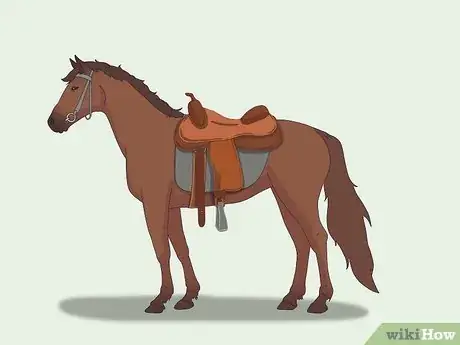
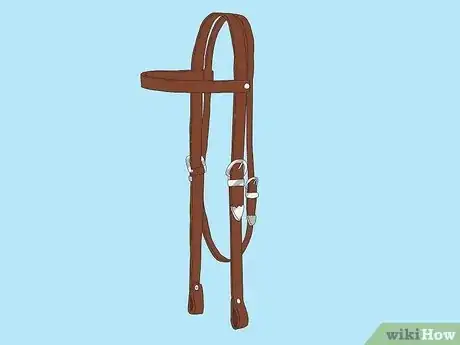
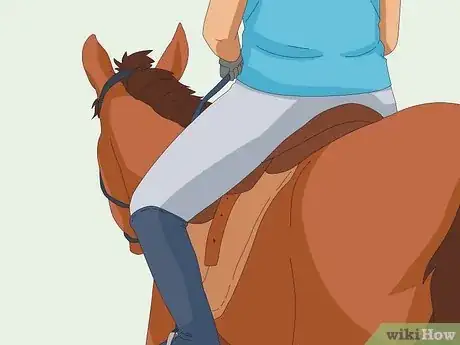
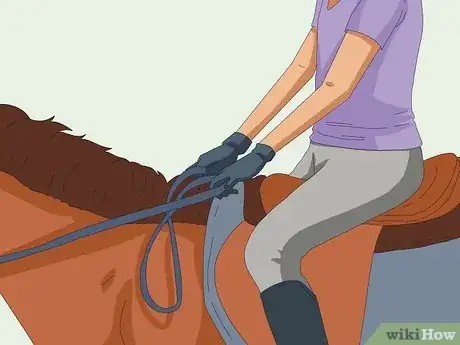

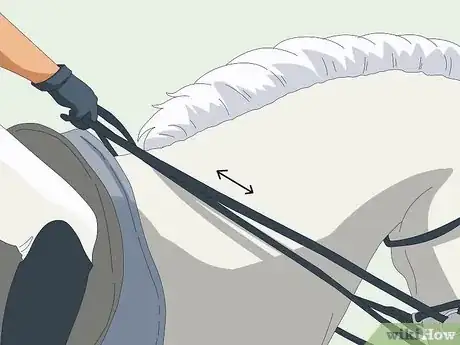



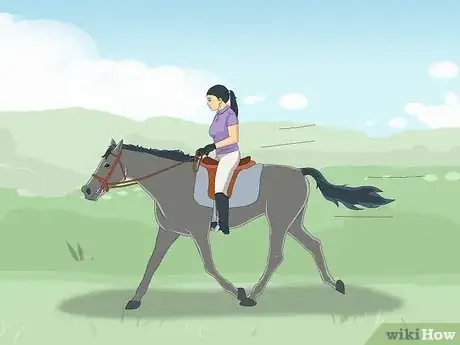


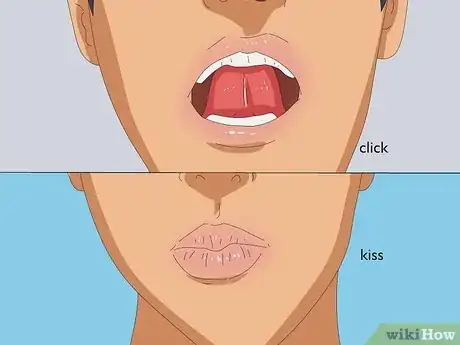

-Step-11.webp)
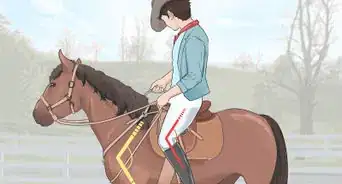
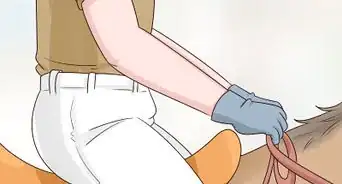
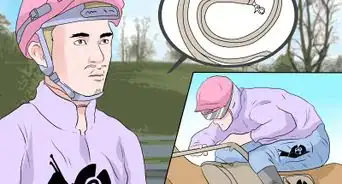
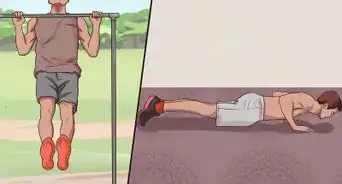












-Step-11.webp)

